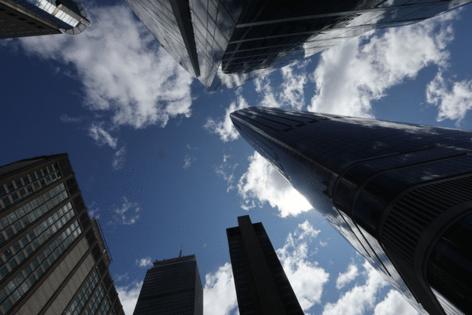Critics fear tall towers turning downtown Boston into Manhattan
Published in Home and Consumer News
BOSTON — Critics of a proposed Boston zoning plan are fuming over new regulations that they say will “Manhattanize” the city’s historic downtown with shadow-casting 700-foot skyscrapers.
Downtown Boston Neighborhood Association representatives say the administration of Mayor Michelle Wu “blindsided” them with the final draft of a downtown plan that would tweak existing zoning regulations in a way that would allow buildings to tower 500-700 feet over the city.
“If we’re going to treat Boston like it’s Boston, the colonial city that it is, then we have to do something to be respectful of all the landmarks that exist and make sure that we don’t have huge amounts of shadow or other weather impacts that are created by large towers,” downtown resident Tony Ursillo told the Herald.
Ursillo and Rishi Shukla, who heads the downtown neighborhood association, say they don’t mind 700-foot skyscrapers in the financial district, where similar towering has historically been allowed by the city.
Their gripe is about extending such height allowances to other parts of the downtown that would threaten its historic character.
Such changes would end up producing the “Manhattanization” of downtown Boston, Ursillo said.
“I don’t think that’s something anybody in the city would like to see,” Ursillo said. “I don’t think this is New York City. You can look around and see that we have a long history of being a little more selective and delicate in how we choose to grow as a city.”
The 700-foot allowance that was revealed late last month came after an earlier draft of the plan drew backlash in January, when 500-foot towers were proposed along the entirety of Washington Street down to Park Plaza, Shukla said.
In Boston, only three buildings exceed 700 feet: 200 Clarendon Street, which is better known as the John Hancock Tower, at 790 feet; the Prudential Tower, at 750 feet; and One Dalton, at 742 feet. All are located in the Back Bay.
“It blindsided all of us, including people who are on the development side,” Shukla told the Herald. “None of us had a clue the city was doing this.”
A few months earlier, Boston’s planning landscape had changed with Mayor Michelle Wu’s appointment of Kairos Shen, a Menino-era planner, to lead the city’s new planning department last September.
“During this time, Kairos Shen came back from the shadows …, from MIT, and took over as the planning chief, and for all intents and purposes, to me, the city basically put out a brand new plan that was its own version of what they thought downtown should be along with zoning to accompany it,” Shukla said.
The changes led to a “contentious” public meeting last January, Shukla said, with residents “irate” over “the city unilaterally trying to plan for the downtown after we had gone through a five-plus-year process,” coupled with the proposal itself for 500–foot buildings in “one of the most historic parts of the city.”
Such a proposal triggers potential issues with the state’s shadow law, he said, which was enacted in 1990 and restricts the creation of new shadows on the Boston Common and Public Garden at certain times of the day.
The city sought and was granted an exemption from the shadow law by the state in 2017 for the redevelopment of the Winthrop Square Garage into the Millennium Tower, a downtown luxury condominium building that stands at 685 feet. Wu, city council president at the time, opposed and voted against the proposed exemption.
Further inflaming tensions, Shukla said, was that he was tipped off to the impending release of the city’s final downtown plan in late May, when he was on the phone with Shen about “charting a path forward” for the proposal.
“So it was that this was sort of a disingenuous phone call that he was having just for the sake of having, which didn’t sit well, obviously,” Shukla said.
His association sees the plan’s proposed height allowances as contradictory to the city’s goal to produce more affordable housing downtown.
Speaking to the city’s inclusionary zoning requirements, Ursillo said developers paying top dollar to build 700-foot towers downtown would be more likely to contribute to a related fund that allows for the creation of affordable units elsewhere in Boston.
“So this idea that it’s going to lead to affordable housing (downtown), we just don’t buy it,” Shukla said.
A final public meeting was held for the downtown zoning plan last Monday, and a vote will be taken by the planning board next month.
Shen, in an interview with the Herald, pushed back on assertions that the community was left out of the planning process. He defended the plan as key to promoting growth downtown, and dismissed the association’s concerns over high-rise buildings being cost-prohibitive for affordable housing.
The new zoning regulations will lead to new residential developments, Shen said, and “transform the downtown into an 18-hour district instead of a 9-5 district.” It will also bring back desperately needed foot traffic for businesses by reinvesting in existing buildings, and allowing owners to reimagine 21st-century workspaces.
He said many community ideas from a years-long process were incorporated into the plan, such as the creation in last January’s draft of a special “sky” zone along Washington Street. Housing projects would be incentivized in that transit corridor, thereby hiking heights for residential buildings from 155 feet to up to 500 feet, Shen said.
“Now, people interpreted that suddenly we were allowing heights everywhere to go up to 500 feet,” Shen said. “That was a misinterpretation, and we decided to eliminate that zone altogether, and say look, in this area now, everything west and north of Washington Street can only go up to 155 feet.”
Developers can go above that limit if their property includes a landmark district and their proposal calls for preservation of the landmark structure on site, provided that the development site exceeds one acre, he said.
“This notion that we’re Manhattanizing the downtown is simply inaccurate,” Shen said. “We’ve always said that the heights are limited by the state legislation regulating shadows on the Common and Public Garden, or the FAA. The 700 foot height, there are only a few areas in the downtown that can achieve that, and they are very far away from Washington Street and Tremont Street.”
©2025 MediaNews Group, Inc. Visit at bostonherald.com. Distributed by Tribune Content Agency, LLC.








Comments